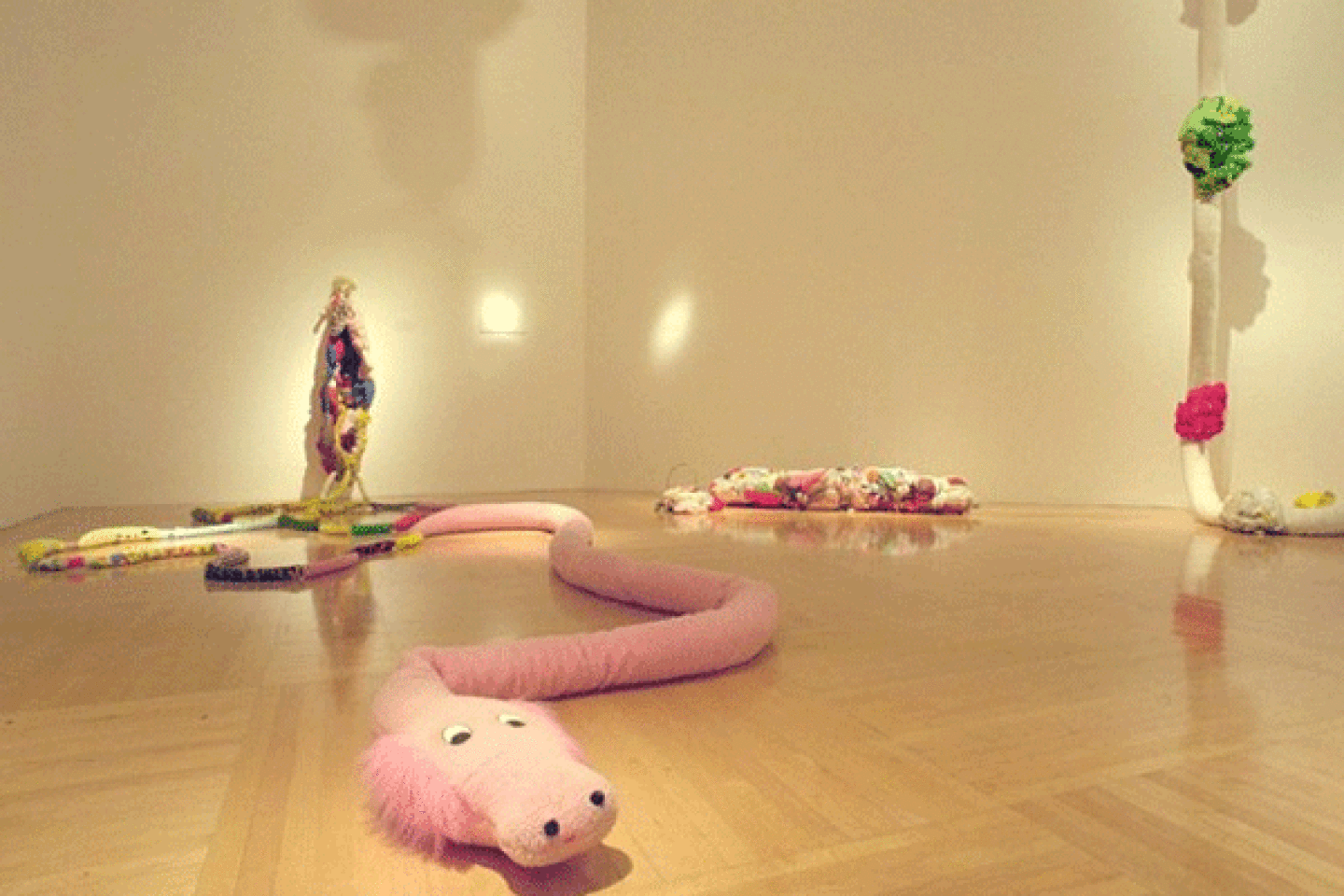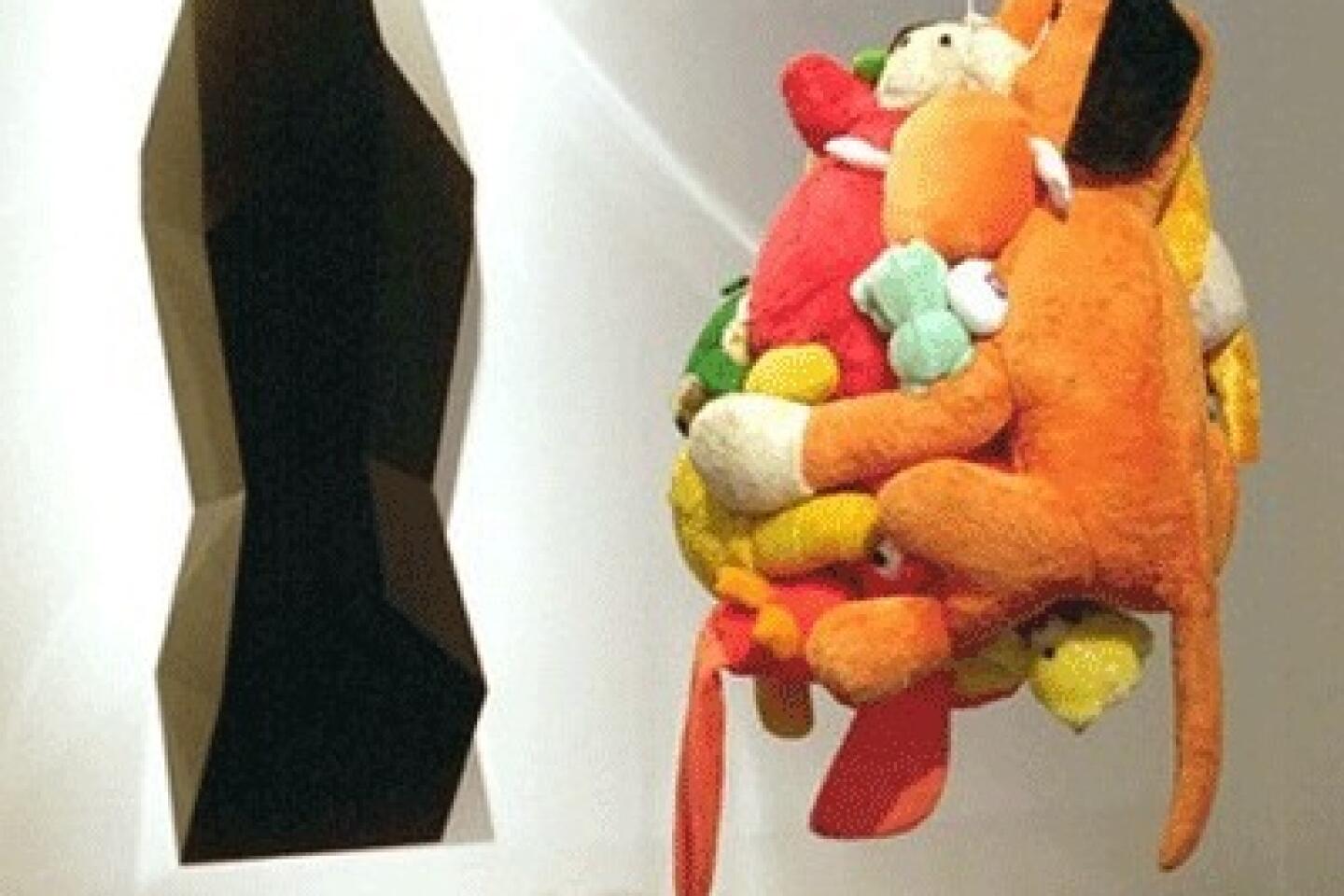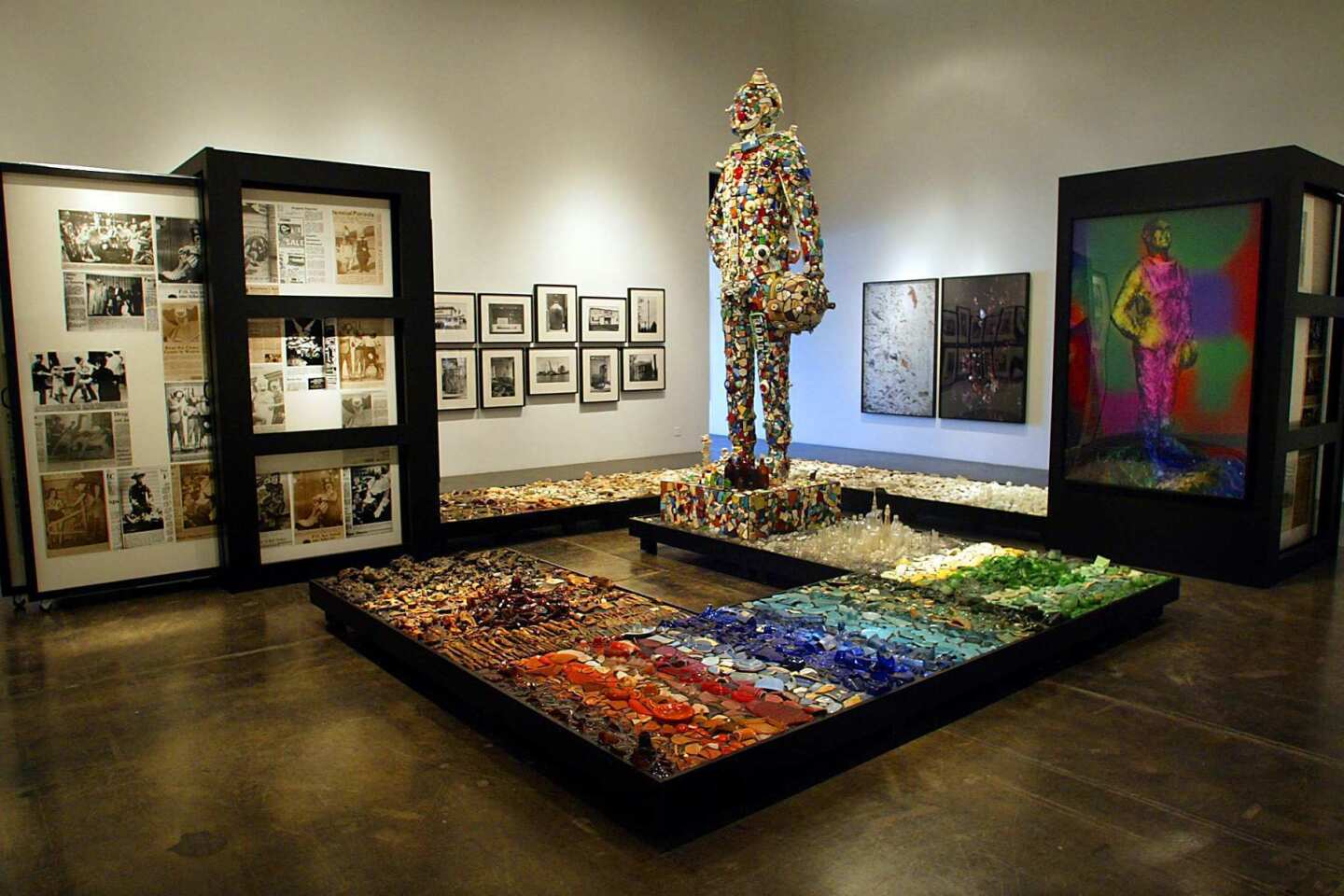Mike Kelley dies at 57; L.A. contemporary artist
Mike Kelley, an influential Los Angeles artist whose physically messy and psychologically complex projects laid the groundwork for present-day installation art, has died. He was 57.
He was found dead Tuesday evening at his home in South Pasadena in what several friends described as a suicide following a serious depression. “We can’t confirm a suicide pending an autopsy or coroner’s report,” said one of the estate’s trustees, art historian John Welchman.
Paul Schimmel, the chief curator of the Museum of Contemporary Art in Los Angeles, called Kelley a “great advocate for artists as well as a great artist,” noting his role teaching at the Art Center College of Design.
PHOTOS: Mike Kelley | 1954-2012
“L.A. would not have become a great international capital of contemporary art without Mike Kelley,” Schimmel said. “Of all the artists in the 1980s, he was the one who really broke out and established a new and complex identity for his generation.”
Kelley’s death came as a surprise to many, but his fans have long recognized the demons that fueled his work, known for its dark humor and punk irreverence. While he rejected the label of bad-boy artist, some of his most famous works are raw or raunchy in their imagery.
Writing in Slate in 2005, novelist Jim Lewis said: “I think I could walk into any collection in the world and spot the Mike Kelley piece immediately (and this despite his many imitators), which is more than I could do with, say, Brice Marden. You can tell the Kelley work because it’s the stuff that itches, the stuff that reeks, the stuff that looks like it needs a good bath.”
Or, as Times art critic Christopher Knight wrote in 1994, “Kelley is an avatar of the power and humanity inherent in recognizing the radical impurity of human experience. His art searches out dark and soiled places where defects, fault lines and inadequacies are obvious and routine, and where failure takes on the poignant, fragile, even heartbreaking beauty that accompanies any loss of self.”
His work spanned multiple mediums over the years, including drawing, painting, sculpture, performance and video. And one of his contributions was pushing the boundaries of installation art to pack subversive themes and unruly mediums into a single space, however uncomfortable for museum and gallery goers.
Kelley was born in Detroit on Oct. 27, 1954, to what he described as a working-class Catholic family. His father was in charge of maintenance for a public school system, and his mother was a cook in the executive dining room at Ford Motor Co.
He attended the University of Michigan in Ann Arbor, where he founded the “anti-rock” band Destroy All Monsters with Jim Shaw, Cary Loren and Lynn Rovner. He and Shaw both moved west in 1976 to attend graduate school at California Institute of the Arts. There Kelley studied with artists such as John Baldessari and Douglas Huebler and teamed up with fellow student Tony Oursler for another art band called The Poetics.
“Mike played the drums and I sang and we both played organ — we both bonded on that probably because of our Catholic upbringing. Though to say ‘played’ is an exaggeration; we made noises,” said Oursler, now best known for his video art.
Besides playing music, Kelley’s main pursuit in school and soon after was performance art. After graduating from CalArts, he began what Welchman describes as “an astonishing series of performances using soliloquies and highly charged poetic prose. They appear to be improvisational but were in fact highly scripted, even the yells and screams.”
But more and more, the props or sound instruments from his performances were becoming sculptural objects themselves, and Kelley found himself working in the loose genre known as installation art. His stage fright ultimately led to his use of video as a way of capturing private performances and not having to perform before a large audience himself.
One of his breakthrough works was called “Monkey Island,” a performance/installation staged in Metro Pictures in 1982 and Rosamund Felsen Gallery in 1983. Its point of departure was a visit Kelley made to the monkey enclosure at the L.A. Zoo, and drawings of monkeys did figure into the work. But so did inflatable bladders and other symbolic objects.
In the 1980s he became known for working with another type of material: crocheted blankets, fabric dolls and other rag toys found at thrift stores and yard sales. Perhaps the most famous work in this vein, “More Love Hours Than Can Ever Be Repaid” from 1987, featured a mess of used rag dolls, animals and blankets strewn across a canvas, a way of investing a fictional childhood scene with some visceral pathos.
“If Monkey Island was his breakthrough piece in terms of the art world in Los Angeles, it was the stuffed animals that became his sort of signature work about remembrance, loss, a certain kind of sadness,” Schimmel said.
Filmmaker John Waters, who owns artwork by Kelley, describes these installations in his 2010 book “Role Models,” calling him “the man who made pitiful seem sexy by turning grimy thrift-store stuffed animals into heartbreaking, jaw-droppingly beautiful sculptures by placing them on stained blankets on the floor or facedown on card tables next to one another like dead Jonestown suicide cultists.”
In 1988 Kelley created an installation called “Pay for Your Pleasure,” which featured a sort of rogue’s gallery of portraits of men of genius — poets, philosophers and artists included — subverted at the end by a painting created by a convicted criminal. It is now in the permanent collection of MOCA.
For curator Emi Fontana, seeing the piece when it traveled to Berlin was so powerful that she says it was one of the reasons she joined the contemporary art world, leaving her work as an art historian specializing in 15th and 16th century Venetian paintings behind to open a gallery in Milan. She calls it “a masterpiece about genius and criminality, about the human psyche.”
Fontana went on to work on multiple projects with Kelley over the years, and had a romantic relationship with him that lasted from 2000 to 2008 and brought her to Los Angeles. She called Kelley a “genius,” describing him as a “voracious reader and an omnivorous listener.”
“What is amazing is how Mike was able to bring the avant-garde underground and the world of fine art together in a way that was really interesting,” Fontana said. “If you think of all these activities like ‘Destroy All Monsters,’ his way of integrating the counterculture into discourse of contemporary art was quite unique.”
Along with his collaborations with Jim Shaw and Tony Oursler, Kelley was also known for working with L.A. artist Paul McCarthy in the 1990s. They collaborated on a series of video projects, including a 1992 work based on Johanna Spyri’s classic children’s book, “Heidi,” which used deformed rubber dolls to enact odd scenes of domestic violence. Because of their interest in the grotesque, some critics group Kelley and McCarthy together.
Schimmel thinks the comparison is a bit superficial. “I think in some ways they are joined together because they became visible internationally around the same time,” he said. “[But] in many respects Paul’s work responds to minimalism, happenings and other influences from the ‘60s. I think Mike is arguably a more conceptual artist: somebody who refers to much more diverse sources, everything from American history to Plato to popular culture.”
These sources all came together in a 2005 show at Gagosian Gallery in New York, an epic video installation called “Day is Done” that brought together 31 sculptures and three hours of video. Kelley has described it as his “pseudo-autobiography.”
Over the years his work was well recognized. He showed with several major galleries, including Metro Pictures and Gagosian in New York, and had work acquired by the Museum of Contemporary Art in Los Angeles, the Whitney Museum of American Art in New York and the Tate Modern in London, among others. A Kelley retrospective is set to be the inaugural show of the Stedelijk museum in Amsterdam when it reopens, currently scheduled for the end of the year. It will travel to the Museum of Contemporary Art in 2014.
But Fontana, who saw Kelley last week for dinner, said that Kelley’s art-world accomplishments had a price, as he had been actively struggling with what it means to succeed in a world that has become more materialistic and foreign to him.
“He had a deep discomfort in seeing what the art world is now,” Fontana said. “He didn’t like the fact that everything has become so corporate. He said to me: ‘If I were to start now, I would never become a visual artist.’
“He really wanted to be an important artist, and he worked all of his life for that. He found himself at the top of his game and then found that the world he was at the top of was a world that he didn’t like. That’s intense existentially.”
Kelley is survived by his older brother George Kelley, who lives near Houston.
More to Read
Start your day right
Sign up for Essential California for the L.A. Times biggest news, features and recommendations in your inbox six days a week.
You may occasionally receive promotional content from the Los Angeles Times.









